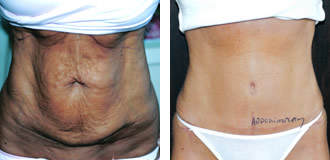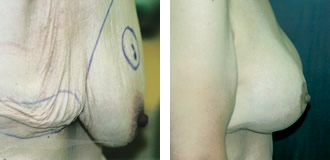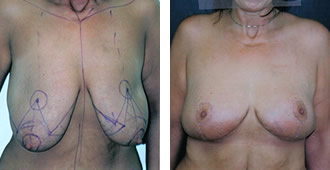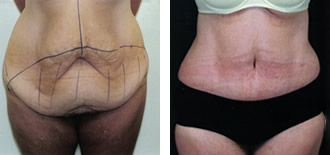POST-BARIATRIC (WEIGHT LOSS) PLASTIC SURGICAL CORRECTION IN BEVERLY HILLS
Posted On: March 07, 2008 Author: The Office of Dr. Stuart Linder Posted In: Body Sculpting, Liposuction, Plastic Surgery
In 2008, patients more than ever are undergoing massive weight loss surgery for morbid obesity. This is seen throughout the country and the numbers are increasing exponentially. Patients who are over twice their body weight or 100 pounds over their body weight may be considered morbidly obese. These patients can have horrible health issues, including high blood pressure, diabetes and other chronic illnesses, including sleep apnea and respiratory problems. These patients can do extraordinarily well with bariatric surgery, including laparoscopic banding procedures as well as V-Y gastroplasties and other forms of gastric surgeries to reduce the size of the stomach. These patients will subsequently lose a tremendous amount of weight, both fat and sometimes skin; however skin laxity becomes a significant problem with these patients. Skin laxity can occur throughout from the head and neck to the abdominal area, chest, as well as thigh region. In other words, all areas of the body and face will be affected.
As Dr. Linder is a Beverly Hills Body Sculptor, we deal with patients who have had post-bariatric surgery all the time. We stress operations on chest and abdominal areas. Patients who have had massive weight loss from bariatric surgery with the breast areas will often have what is referred to as involutional atrophy (complete loss of fullness of the breasts), as well as grade 3 ptosis. The nipple areolar complex is well below 3 cm of the inframammary fold and often the nipple areola is at the bottom of the breast. These patients do well with surgery, including augmentation mammoplasty (silicone or saline implants), with the implants placed under the muscle through a small incision under the nipple, as well as often a concurrent mastopexy or a breast lift, usually a formal mastopexy using the inferior pedicle Wise-pattern technique or the anchor scar. Skin laxity cannot be addressed with implant alone in most cases and therefore a breast usually has to be performed. It is very important that the patient seek a Board Certified Plastic Surgeon who specializes in body sculpting procedures and reconstruction of the body in order to get the best chances of an excellent result.
The abdominal areas on patients who are status post gastric bypass surgery and morbid obesity can be very significant with massive amounts of skin over-draping, causing even hygienic problems and rashes along the suprapubic region. These patients do great with a panniculectomy. A panniculectomy is really an abdominoplasty of massive amounts of skin and sometimes the midline plications muscles are not tightened. Frequently, liposuction of the iliac crest rolls or hip area can be performed if necessary to reduce and narrow the hips and concurrently with a panniculectomy. A panniculectomy is a surgery where a patient has skin removed from the lower suprapubic region, extended to the anterior superior iliac spine bilaterally and dissecting all the way up close to the subcostal margins or up towards the lower ribcage. Care has to be taken not to dissect too high, as this could cause blood supply problems and the possibility of skin necrosis. In most cases, the umbilicus can be saved and the umbilical stock can then be repositioned to its new position through a new donor hole region. Panniculectomies if they are large should staged from a breast augmentation lift in order to reduce general anesthesia time and estimated blood loss. Often, we will do one surgery, wait at least three to six months and then perform the second surgery. Patients can also have problems with arms and thighs, with skin laxity requiring brachioplasty of the arms and thigh lifts to he medial and lateral thighs. This will do well removing skin and fat, tightening the medial thighs up to the fascia around the suprapubic region. However, the scarring here can be quite significant with widespread scarring. Scars can migrate inferiorly and patients can be very distraught with this. The brachioplasty is often an excellent surgery, removing skin along the arms from the upper condyle, all the way up into the axillary region. Again, these scars can be quite distressing as well. It is very important that patients understand that when they are undergoing panniculectomies and breast lift surgeries after a massive weight loss and bariatric surgery, that they are going to have significant scars and that there is no 100% guarantee as to the final nature of the scar, which can be hypertrophic, keloids, hyperpigmented, widespread, hypopigmented or a variety of the above. There is no way any plastic surgeon on this planet can guarantee the final nature and quality of the scar.
Finally, patients who are healing from after plastic surgery and after post-bariatric surgery must make sure they take proper nutrients in order to allow for proper wound healing and that starvation post-surgery is not a good idea obviously in that patients need good proteins, as well as vitamins, good oxygenation and so forth, in order to allow for proper healing. Patients should never smoke prior to these large surgeries as this will significantly increase skin necrosis, flap death, as well as problems with blood supply.



